
Aronia is a genus of deciduous shrubs, the chokeberries, in the family Rosaceae native to eastern North America and most commonly found in wet woods and swamps. The genus is usually considered to contain two or three species, one of which is naturalized in Europe. A fourth form that has long been cultivated under the name Aronia is now considered to be an intergeneric hybrid, × Sorbaronia mitschurinii.

Heteromeles arbutifolia, commonly known as toyon, is a common perennial shrub native to extreme southwest Oregon, California, and the Baja California Peninsula. It is the sole species in the genus Heteromeles.
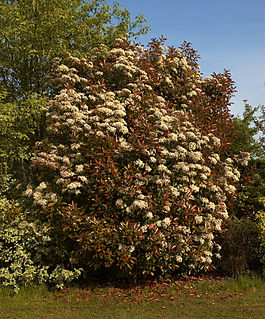
Photinia is a genus of about 40–60 species of small trees and large shrubs, but the taxonomy has recently varied greatly, with the genera Heteromeles, Stranvaesia and Aronia sometimes included in Photinia.

Stranvaesia is a genus of flowering plants in the family Rosaceae. Its morphology is so similar to Photinia that it has sometimes been included within that genus, but recent molecular data indicate that the two genera are not related.
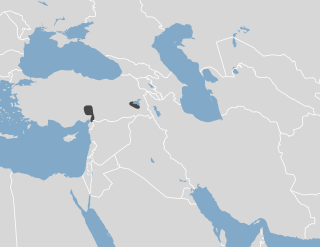
Père David's mole is a mole found in the Middle East, ranging from south-central Turkey east to Kurdistan Province, Iran, although it could also range south into Syria. It is listed as a data deficient species. The species is named after the zoologist Armand David. As T. streeti, it is known as the Persian mole.
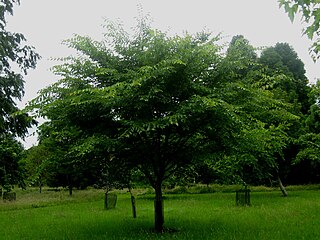
Ulmus davidiana, also known as the David elm, or Father David elm, is a small deciduous tree widely distributed across China, Mongolia, Korea, Siberia, and Japan, where it is found in wetlands along streams at elevations of 2000–2300 m (6,500–7,500 ft). The tree was first described in 1873 from the hills north of Beijing, China.
Ulmus davidianavar.japonica 'JFS-Bieberich' is a Japanese Elm cultivar that was raised by the Sunshine Nursery, Oklahoma, from seed collected in China by proprietor Steve Bieberich. Emerald Sunshine proved only moderately successful in the US National Elm Trial, averaging a survival rate of 70% overall.
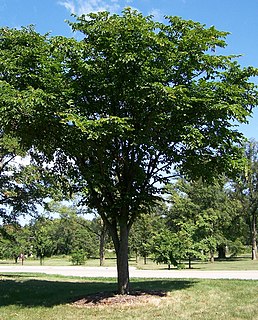
Ulmus laciniata var. nikkoensisRehder, the Nikko elm, was discovered as a seedling near Lake Chūzenji, near Nikkō, Japan, and obtained by the Arnold Arboretum in 1905. The taxonomy of the tree remains a matter of contention, and has been considered possibly a hybrid of U. laciniata and U. davidiana var. japonica. However, in crossability experiments at the Arnold Arboretum in the 1970s, U. laciniata, a protogynous species, was found to be incompatible with U. davidiana var. japonica, which is protandrous.
The Japanese Elm cultivar Ulmus davidianavar.japonica 'Reperta' was a University of Wisconsin–Madison selection named and registered in Germany by Conrad-Appel, Darmstadt, in 1993.
Ulmus davidiana var. davidiana is variety of elm. The tree is restricted to the Chinese provinces of Hebei, Henan, Shaanxi and Shanxi.
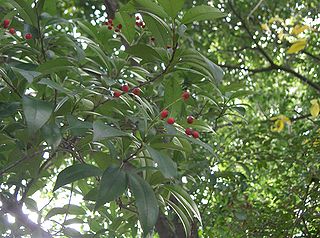
Photinia glabra, the Japanese photinia, is a species in the family Rosaceae.

Photinia serratifolia, commonly called Taiwanese photinia or Chinese photinia is a flowering shrub or tree in the flowering plants family Rosaceae, found in mixed forests of China, Taiwan, Japan, the Philippines, Indonesia, and India.
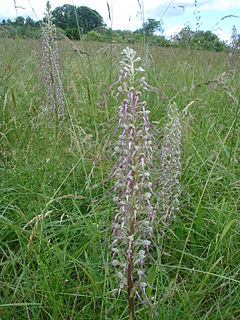
The Jardin botanique du col de Saverne, also known as the Jardin botanique de Saverne, is a botanical garden and arboretum located along the Col de Saverne near Saverne, Bas-Rhin, Alsace, France. It is open on weekends, and daily in the warmer months; an admission fee is charged.
Ulmus×mesocarpaM. Kim & S. Lee is a natural hybrid elm which is a cross of Ulmus macrocarpa with Japanese elm Ulmus davidiana var. japonica discovered on Seoraksan near the city of Sokcho on the eastern coast of South Korea. The tree is endemic to the provinces of Gangwon-do, Injegun, Bukmyeon, Yongdaeri, and Baekdamsa.

Caloptilia zachrysa is a moth of the family Gracillariidae. It is known from China, India, Japan, Korea, Sri Lanka and Taiwan.
The Japanese Elm cultivar Ulmus davidianavar.japonica 'Validation' is a selection made by Kunso Kim and Bethany Brown of the Morton Arboretum released in 2011; propagation is by grafting onto Siberian Elm Ulmus pumila rootstocks.
Chinese photinia is a common name for several plants and may refer to:

Photinia villosa is a species in the flowering plant family Rosaceae, with common names Christmas berry and oriental photinia. It is a shrub or small tree up to 5 metres (16 ft) tall, native to China, Japan, and Korea. This plant was recently introduced into the United States, likely as a landscaping or garden plant. It has escaped cultivation and has become increasingly invasive in northern New Jersey, eastern Pennsylvania, and parts of Virginia, New York and Connecticut.

Prunus davidiana is a species in the genus Prunus in the family Rosaceae. It is also known by the common names David's peach and Chinese wild peach. It is native to China, preferring to grow in forests and thickets, on slopes in mountain valleys, and in waste fields, from 800 to 3200 m. It is resistant to frost, and to a number of pests and diseases of cultivated peach, and is the subject of many studies for the genetic improvement of peaches.

Photinia × fraseri, known as red tip photinia and Christmas berry, is a nothospecies in the rose family, Rosaceae. It is a hybrid between Photinia glabra and Photinia serratifolia.















